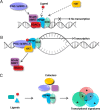Minireview: Challenges and opportunities in development of PPAR agonists
- PMID: 25148456
- PMCID: PMC5414793
- DOI: 10.1210/me.2013-1427
Minireview: Challenges and opportunities in development of PPAR agonists
Abstract
The clinical impact of the fibrate and thiazolidinedione drugs on dyslipidemia and diabetes is driven mainly through activation of two transcription factors, peroxisome proliferator-activated receptors (PPAR)-α and PPAR-γ. However, substantial differences exist in the therapeutic and side-effect profiles of specific drugs. This has been attributed primarily to the complexity of drug-target complexes that involve many coregulatory proteins in the context of specific target gene promoters. Recent data have revealed that some PPAR ligands interact with other non-PPAR targets. Here we review concepts used to develop new agents that preferentially modulate transcriptional complex assembly, target more than one PPAR receptor simultaneously, or act as partial agonists. We highlight newly described on-target mechanisms of PPAR regulation including phosphorylation and nongenomic regulation. We briefly describe the recently discovered non-PPAR protein targets of thiazolidinediones, mitoNEET, and mTOT. Finally, we summarize the contributions of on- and off-target actions to select therapeutic and side effects of PPAR ligands including insulin sensitivity, cardiovascular actions, inflammation, and carcinogenicity.
Figures



References
-
- Centers for Disease Control and Prevention. National Diabetes Fact Sheet: national estimates and general information on diabetes and prediabetes in the United States, 2011. Atlanta: US Department of Health and Human Services; 2011.
-
- Leiter LA, Fitchett DH, Gilbert RE, et al. . Identification and management of cardiometabolic risk in Canada: a position paper by the cardiometabolic risk working group (executive summary). Can J Cardiol. 2011;27:124–131. - PubMed
-
- Beckman JA, Creager MA, Libby P. Diabetes and atherosclerosis: epidemiology, pathophysiology, and management. JAMA. 2002;287:2570–2581. - PubMed
Publication types
MeSH terms
Substances
LinkOut - more resources
Full Text Sources
Other Literature Sources
Medical

